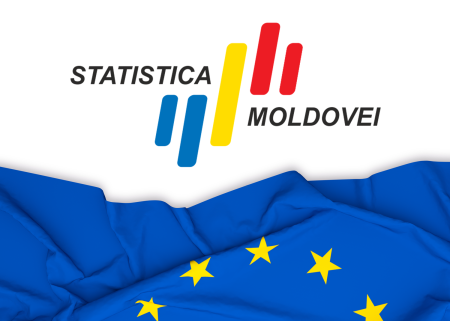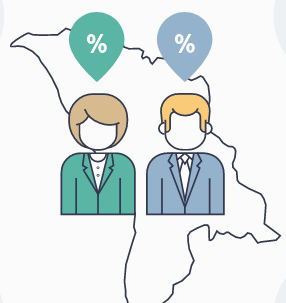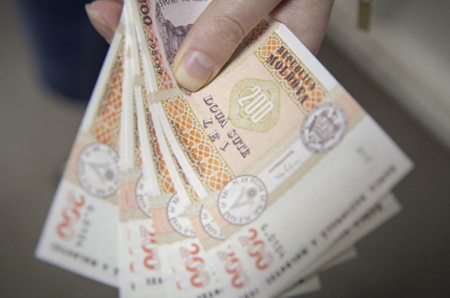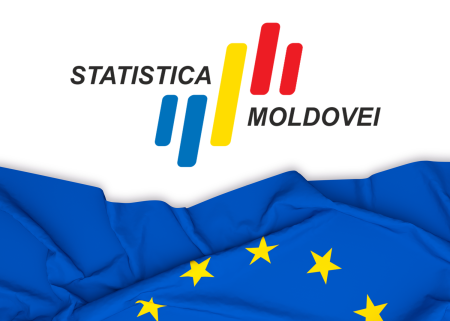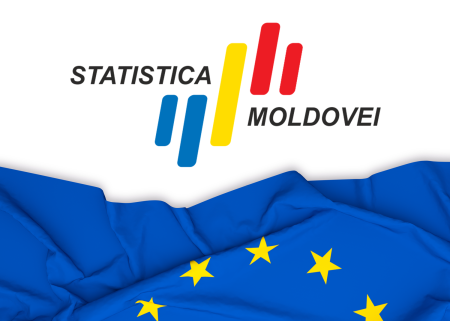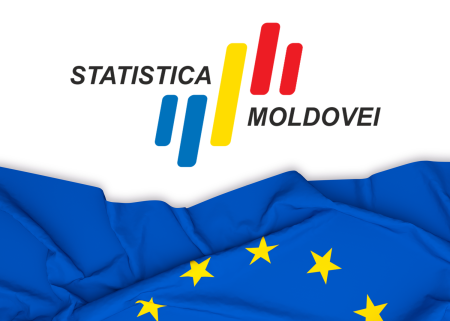Search info
(Comunicat) The activity of insurers in 2020
The National Bureau of Statistics informs that in 2020 the gross premiums charged constituted 1453,6 million lei, decreasing by 10,6% compared to the gross premiums charged in previous year.
(Noutăți) Job position for Expert in communication and visibility for official statistics
The EU funded project “Technical Assistance to Support the National Bureau of Statistics of the Republic of Moldova” is seeking for high-qualified national applicants for the position of Expert in communication and visibility for official statistics at the National Bureau of Statistics of the Republic of Moldova.
(Noutăți) "Quarterly statistical bulletin, January-December 2020" posted on the website
The bulletin contains data in dynamics in the form of tables statistical indicators for years, quarters, months, which characterize the social, economic and demographic situation of the country. Information on main social and economic situation of CIS countries is presented.
(Comunicat) The evolution of industrial production prices in February 2021
Industrial production price indices
The National Bureau of Statistics informs that, in February 2021 the producer prices in industry increased by 0,8% compared to January 2021, with 5,6% - compared to February 2020, and with 2,1% - compared to December 2020.
(Comunicat) Gross Domestic Product in the Republic of Moldova in the quarter IV and in 2020
The National Bureau of Statistics informs that, the Gross Domestic Product, estimated for the quarter IV of 2020, in nominal value amounted to 56318 million lei current market prices. Compared to the quarter IV 2019, GDP decreased by 3,3% on the gross series and by 4,4% on the seasonally adjusted series.
(Noutăți) The quarterly publication "Social-economic situation of the municipality Chisinau in January-December 2020" posted on the website
The publication contains quarterly statistical information which presents the economic, social and demographic situation of the municipality Chisinau. The publication contains statistical indicators regarding demographic situation, labour market, health, tourism, crimes, agriculture, industry, investments in fixed assets, construction and transport.
(Comunicat) The touristic activity of the tourism agencies and tour-operators in 2020
The National Bureau of Statistics informs that, in 2020 the tourism agencies and tour-operators provided tourism services to 124,5 thousand tourists and excursionists, which represents 33,1% compared to 2019. The number of tourists and excursionists in the reporting year compared with 2019, decreased by 252,1 thousand visitors, the decreased was caused by the decrease of the number of participants of outbound tourism with 235,9 thousand visitors (-76,0%), domestic tourism - with 12,9 thousand visitors (-65,0%) and inbound tourism - with 3,3 thousand visitors (-7,1%).
(Comunicat) Evolution of consumer prices in the Republic of Moldova in February 2021
The National Bureau of Statistics informs that in February 2021 the annual inflation registered 0,62%, including food products 1,80%, nonfood products 1,15% and services (-1,89%). The average consumer prices in February 2021 compared to January 2021 increased by 0,38%.
(Comunicat) Labour Force in the Republic of Moldova: Employment and unemployment in the IV-th quarter of 2020
According to the results of the Labour Force Survey, in the IV-th quarter of 2020, the labour force of the Republic of Moldova, which includes the employed and unemployed population, was 877,4 thousand persons, decreasing by 1,2% in comparison to the IV-th quarter of 2019.
(Comunicat) The evolution of sale prices of agricultural products by agricultural enterprises in 2020
Sales indices of agricultural production prices
The National Bureau of Statistics informs that producer prices of agricultural products in 2020 registered 122,5% compared to 2019.
(Comunicat) Statistical portrait of women and men from Moldova
The National Bureau of Statistics communicates about the release of the statistical portrait of women and men in the Republic of Moldova. The synthesis presents statistical data on women and men, reflecting their situation in all areas of society.
(Comunicat) Average earnings in the IV-th quarter 2020
The National Bureau of Statistics informs that the average gross monthly nominal earnings at the units in the real sector with 4 and more employees as well all budgetary institutions amounted to 8107,5 lei in 2020, increasing by 10,2% compared to year 2019.
(Comunicat) Average earnings in the IV-th quarter 2020
Number of employees and vacancies
The National Bureau of Statistics informs that the average gross monthly nominal earnings at the units in the real sector with 4 and more employees as well all budgetary institutions amounted to 8107,5 lei in 2020, increasing by 10,2% compared to year 2019.
(Comunicat) Investments in fixed assets in 2020
The National Bureau of Statistics informs that, in 2020, the entities in the real sector with 5 and more employees and the budgetary institutions made investments in fixed assets amounted to 27,1 billion lei or 2,6% less compared to 2019.
(Comunicat) Crime situation in the Republic of Moldova in 2020
According to information of the Ministry of Internal Affairs in 2020, 26,3 thousand crimes were recorded on the territory of the country, registering a decrease of 17,0% compared to the previous year and 37,2% compared to 2016. The crime rate is 100 offenses per 10 thousand residents compared to 120 offenses in 2019 and 151 in 2016.
(Comunicat) Attendance of collective tourist accommodation establishments in 2020
National Bureau of Statistics informs that 90,3 thou. tourists attended collective tourist accommodation establishments in the period of January-December 2020, of which 61,6 thou. were resident tourists (68,2% of total) and 28,7 thou. - non-resident tourists (31,8%).
(Comunicat) Dwellings put into operation in 2020
The National Bureau of Statistics informs that in 2020 were put into operation 6 906 dwellings (apartments and individual residential houses) with total area of 545,5 thousand m2, or with 20,7% more than in 2019.
(Comunicat) Construction activity in entrepreneurship in January-December 2020
The National Bureau of Statistics informs that, according to preliminary data, in January-December 2020, the construction works executed by the entities amounted to 14,0 billion lei, increasing by 3,7% in comparable prices compared to the similar period of 2019.
(Noutăți) Job positions for assisting the National Bureau of Statistics of the Republic of Moldova in implementing the revised IAIS to ensure the standardisation of statistical processes
The EU funded project “Technical Assistance to Support the National Bureau of Statistics of the Republic of Moldova” is seeking high-qualified national applicants for two full time fixed term positions: Frontend Developer (A) and Backend Developer (B) for the development and implementation of the Integrated Automated Information System at the National Bureau of Statistics of the Republic of Moldova.
(Noutăți) IT expert to assist the National Bureau of Statistics of the Republic of Moldova for developing a concept document on the Integrated Automated Information System
The EU funded project “Technical Assistance to Support the National Bureau of Statistics of the Republic of Moldova” is seeking high-qualified national applicants for preparing a concept document on the Integrated Automated Information System that is being developed at the National Bureau of Statistics of the Republic of Moldova.
(Comunicat) Turnover in trade and services in 2020
National Bureau of Statistics informs that, in December 2020, turnover in retail trade registered an increased of 17,2% compared to previous month and with 18,5% compared to December 2019. In 2020, turnover in retail trade increased with 4,6% compared to 2019.
(Comunicat) Industrial activity in 2020
National Bureau of Statistics informs that, in December 2020, the industrial production decreased by 1,8% compared to the corresponding month of the previous year, as a result of decrease of the manufacturing industry (with 5,6%). In the same time the quarrying industry (+32,5%) and production of electricity, gas, steam, hot water and air conditioning supply (+12,1%) registered an increase.
(Comunicat) International trade of goods of the Republic of Moldova in 2020
National Bureau of Statistics informs that, in 2020 exports summed up 2485,2 millions USD, less than in 2019 with 10,6% and imports summed up 5415,7 millions USD, less than in 2019 with 7,3%.
(Comunicat) Passengers and freight transportation in the Republic of Moldova in 2020
The National Bureau of Statistics informs that 55,6 million passengers were transported with public transport in 2020, with 46,1% less than in 2019. The passengers turnover constituted 2434,7 million passenger-kilometers, with 59,2% less than in 2019.
(Comunicat) Evolution of consumer prices in the Republic of Moldova in January 2021
The National Bureau of Statistics informs that in January 2021 the annual inflation registered 0,22%, including food products 1,26%, nonfood products (-0,08%) and services (-0,95%).
(Comunicat) Building permits issued in 2020
National Bureau of Statistics informs that in 2020, 3038 building permits for residential and non-residential buildings were issued, less with 1,9% compared to 2019, the reduction being caused by the decrease in the number of permits issued for non-residential buildings.
(Comunicat) Agricultural activity in 2020
National Bureau of Statistics informs that, the global agricultural production, in all types of households in 2020, according to preliminary estimations, registered 72,9% compared to 2019. The decrease of the global agricultural production was determined by the decrease of the vegetable production with 35,9% and livestock production with 3,8%.
(Comunicat) The evolution of industrial production prices in December 2020
Industrial production price indices
The National Bureau of Statistics informs that, in December 2020 the producer prices in industry increased by 0,7% compared to November 2020, and with 3,8% compared to December 2019.
(Comunicat) Industrial activity in January-November 2020
National Bureau of Statistics informs that, in November 2020, the industrial production increased by 2,7% compared to the corresponding month of the previous year, as a result of increase of the quarrying industry (+31,5%) and production of electricity, gas, steam, hot water and air conditioning supply (+28,7%). In the same time the manufacturing industry registered an decrease (-2,4%).
(Noutăți) Job positions for assisting the National Bureau of Statistics of the Republic of Moldova in implementing the revised IAIS to ensure the standardisation of statistical processes
The EU funded project “Technical Assistance to Support the National Bureau of Statistics of the Republic of Moldova” is seeking high-qualified national applicants for two full time fixed term positions: Frontend Developer (A) and Backend Developer (B) for the development and implementation of the Integrated Automated Information System at the National Bureau of Statistics of the Republic of Moldova.
reset WAYcursor WAYcontrast WAYMarire Font WAYCiteste cu voce textul selectat WAYLinkuri WAY



